The Noises have long been a place of research and conservation. Some of the current projects include:
Archaeological work
On the main beach of Ōtata Island is a large, historic midden, made up of layers of shells, animal bones and other archaeological evidence. A midden can be read, much like an encyclopedia, to teach us about events geological, weather or fires, and also the presence of animals and humans. That ‘encyclopedia’ of biological material sits alongside the oral histories of mana whenua, as well as the information gathered over the years by the Neureuter family. Sadly, up to five metres of that midden were lost in a large storm in January 2018.
Aware of the need to preserve the midden before it degraded further, Auckland Museum Archaeologists Dr Louise Furey and Emma Ash worked in collaboration with mana whenua, Ngāi Tai ki Tāmaki, and the Neureuter family, to undertake excavations of the Ōtata midden, with digs taking place during the March 2020 and again in February 2021.
In the first dig, the team excavated three 1x1m sq sections by the bucketload, with the contents of each bucket sieved, bagged, numbered and details noted. At the end of the excavation, soil and rocks were returned to the hole they came from and bags were filled with shell, bone and charcoal. The 400 bags weighed between 1 and 3kgs each.
Back at the Museum, samples were sorted and placed in large bins according to square and layer, then put in the Museum’s walk-in freezer for two weeks to kill any insects or bugs before being sent to the lab.
Sorting is always laborious, with each bag weighed then tipped into a tray while identifiable shells are sorted into piles, and charcoal and bone fragments placed in their respective piles as fragments are worked through. Once all the shell fragments have been sorted and whole shells counted, this gives an indication of the number and proportion of each species in the bag, providing quantitative data on what people were eating, reflecting both availability and personal preference.
“We will learn what Māori were doing on the island at different times by analysing each layer,” Louise explains. “There is tephra (ash) from Rangitoto separating the two lower cultural layers indicating that the island was first occupied before Rangitoto existed. Storms are also recorded within the profile of the bank – small pebble layers and a thick layer of beach shell to show the island had been subjected to serious storm events in the past.”
The thing that most surprised Louise was finding Rangitoto tephra. “There are very few known sites in Auckland from the 14th century, because of erosion and coastal development. So, this is a rare site, offering a glimpse of what the Gulf was like at that time. There is even a kaka bone in the lower layer.”
This partnership between Auckland Museum and mana whenua is part of the new bicultural approach for how archaeologists and iwi interact. It’s also an active response to coastal erosion with the common goal of gathering information from vulnerable sites in the Hauraki Gulf.
Read blogs from archaeologist Emma Ash here (2020 and 2021)
Listen to RNZ coverage here.
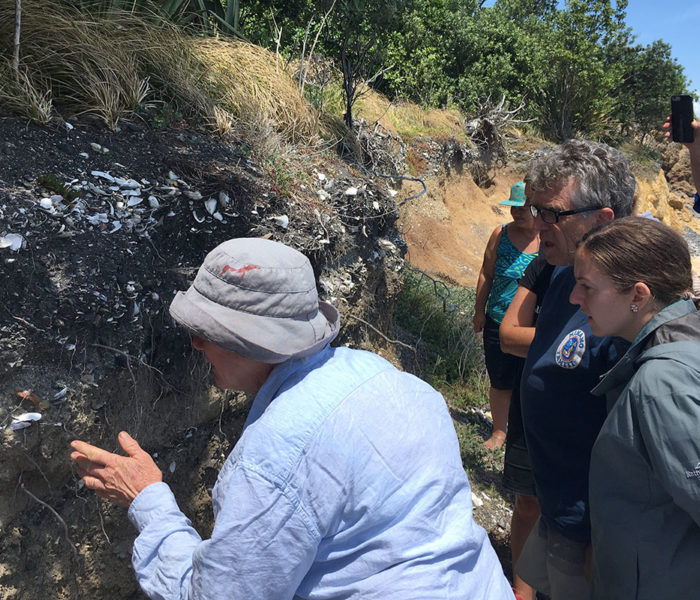
Inspecting the midden, January 2020. Photo: Katina Conomos.
Spotted shag colony
The Hauraki Gulf is home to a threatened population of spotted shags or parekareka, a bird that is genetically distinct from all other shags in New Zealand. And while the spotted shag is relatively common in other parts of the country, in the Hauraki Gulf the birds are now limited to just two colonies, one on pest-free Tarahiki Island and a promontory on Waiheke Island which is also troubled by rats. And last time a bird survey was conducted by Dr Matt Rayner and Dr Tim Lovegrove, they estimated the population was sitting at around 300 breeding pairs.
In an attempt to attract the endearingly elegant spotted shag back to The Noises where the birds once bred, in February 2019 Auckland Museum and Auckland Council, in partnership with the Neureuter Family, created and installed a replica colony of spotted shags on a steep cliff face on the north eastern side of Ōtata Island.
The replicas were based on six spotted shag specimens that were found in the Auckland Museum’s collection and collected by Museum staff from The Noises back in 1913. The Museum’s specimens were scanned, 3D printed and painted. The result, while static, is surprisingly life-like.
As well as the replica birds, nests have been constructed from dried seaweed and white paint has been artfully splashed, in an effort to mimic the appearance of droppings that mark seabird colonies. A solar-powered sound system has been installed and it plays spotted shag breeding calls to further attract birds to the site.
For quite some time it looked as if the clever creatures weren’t going to be fooled by the sham shags but, in recent news, a group of inquisitive birds were spotted stopping by the site last Easter. Whether they were scouting the area for future family planning, or just stopping off on their way from A to B, or on feeding missions, the sighting of an estimated 19 birds is encouraging.
And one thing you can be sure of, eyes will be peeled over the coming months to see if any of the birds have returned to nest, with laying seasons in the Gulf focused around August. December and March.
Damian Christie from the Aotearoa Science Agency was on hand to film the installation.
You can also watch Auckland Biodiversity ecologist Tim Lovegrove and Auckland Museum’s Matt Rayner take part in an annual survey to monitor the threatened populations of Spotted Shags in the Hauraki Gulf.
Geckos and wetapunga
Geckos are an important component of native ecosystems both as predator and prey, and play a role in plant pollination and seed dispersal. The gecko population from The Noises has since been used as a source population for translations to other islands within the Hauraki Gulf.
In 2014, the Auckland Zoo surveyed Motuhoropapa and Ōtata Islands to determine whether the habitat was suitable for wētāpunga. The first release of approximately 1000 wētāpunga was carried out on Motuhoropapa Island in 2015. There have been three subsequent releases of different genetic stock on both Motuhoropapa and Ōtata totalling approximately 1600 critters. Several surveys have confirmed the outstanding success of the releases and wētāpunga are thriving. They may be used for future translocations to other islands in the Hauraki Gulf.
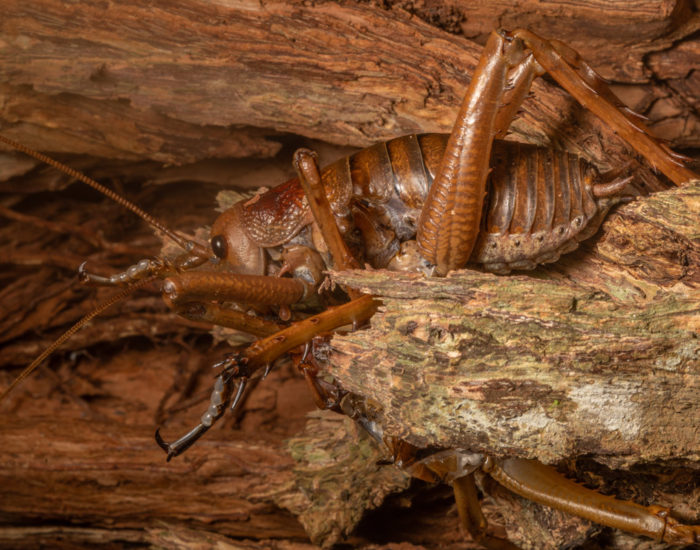
Wētāpunga. Photo: Shaun Lee.
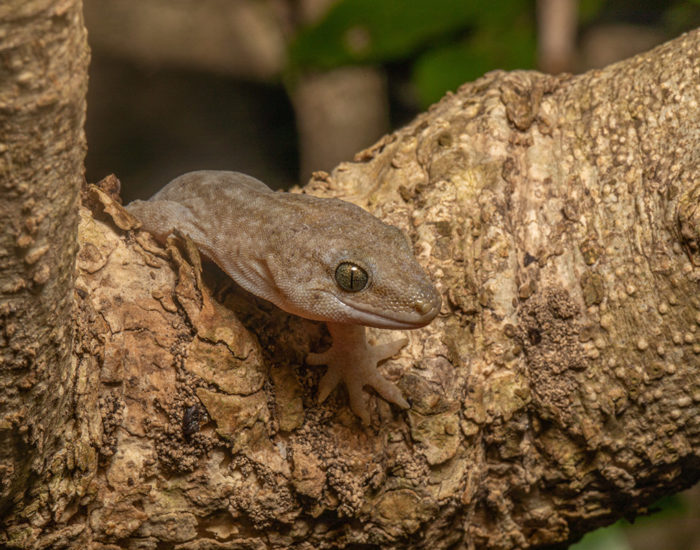
Raukawa gecko. Photo: Shaun Lee.
Kina barrens
Many of the shallow rocky reefs around The Noises are overrun with kina (the sea urchin Evechinus chloroticus). This is a direct result of decades of intense fishing pressure on snapper and crayfish, which are the main predators of kina. In the absence of predators, kina proliferate and graze down the kelp forests forming “kina barrens”. The kina within the barrens are typically small and of little value as kaimoana. As part of a collaborative project with iwi, University of Auckland researchers are mapping the extent of kina barrens in the Hauraki Gulf, including around The Noises, and developing methods to restore kelp forests in areas that are currently kina barrens.
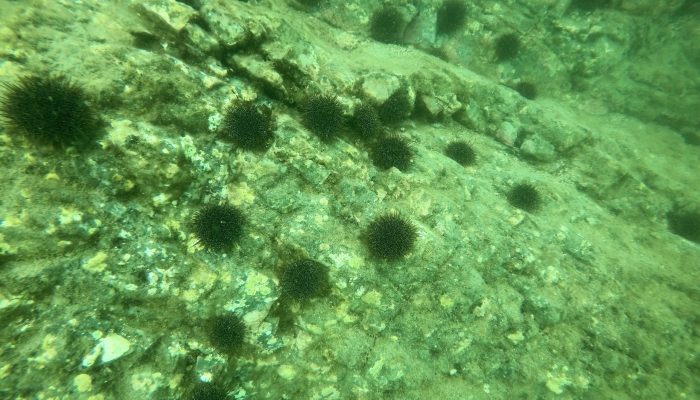
Kina barrens in shallow water (~3 m) on the northern side of Otata. Note the absence of seaweeds and encrusting life on the reef. Photo: Nick Shears.
The impacts of boat noise
Many marine animals rely on making sound and listening for sound cues as a matter of survival. The University of Auckland have placed a camera on Ōtata Island and a hydrophone in the bay to gather data to determine the impact recreational boat noise is having on the reef systems around The Noises. It’s worth noting the camera could also provide visual information confirming recreational fishing pressure being exerted around Ōtata Island. This study commenced in 2019 and will run through to 2021.
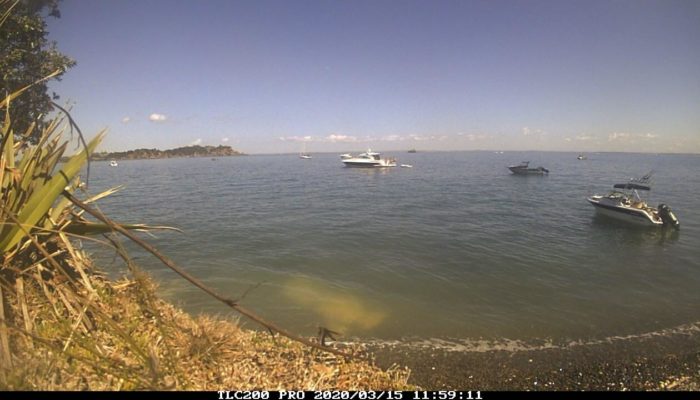
Photograph from the camera on Ōtata Island.
Other seabird research
Seabirds of The Noises have been studied for many years. In November 2019, Auckland Council commenced a 10-year study of the takahikare/white-faced storm petrels, pakaha/fluttering shearwaters, kuaka/northern diving petrels, oi/grey-faced petrels, and korora/little blue penguin on Ruapuke/Maria Island, with plans to extend the study to include Ōtata and Motuhoropapa. Regular bird population counts are also undertaken by scientists and the Neureuter family.
The University of Auckland, in conjunction with the Northern New Zealand Seabird Trust have had a number of PhD students use the islands as a base to study the korora/little blue penguins and oi/grey-faced storm petrels, examining matters such as stress, foraging and the impacts of plastic pollution.
In 2019 a solar powered sound system was installed on the upper slopes of Ōtata Island. This system plays a night-time chorus of seabird calls including oi/grey-faced petrel, kuaka/northern diving petrel, pakaha/fluttering shearwater, and takahikare/white-faced storm petrels in order to speed up the recolonization of the island after predator removals.
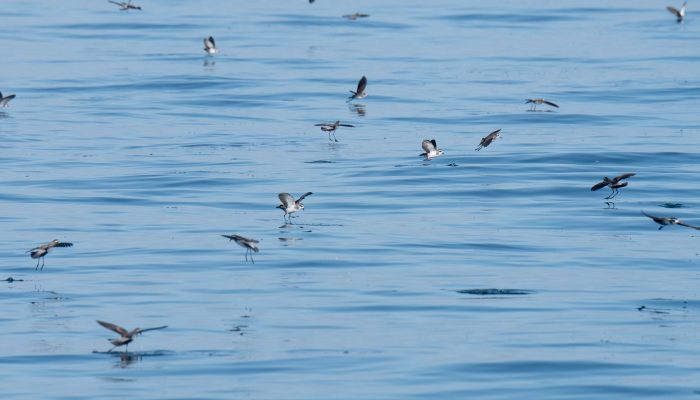
Takahikare/white-faced storm petrels. Photo: Edin Whitehead.
